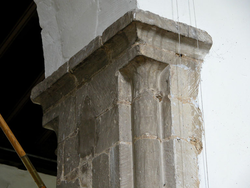
The Corpus of ROMANESQUE SCULPTURE in Britain & Ireland

Glossary

A turned shaft usually combining convex and concave curves, typically found in the Anglo-Saxon period.

A form of cable ornament found, for example, on the neckings of capitals, in which the roll is carved like a screw-thread.
The moulded foot of a column, half-column, pier or pilaster, usually resting on a plinth.

A compartment in the layout of a church, marked by shafts, main arcade and often by vaulting over each single compartment.

An ornament in the form of a bird's head, or a human or beast's head, superimposed on the roll moulding of an arch. Beakhead is predominantly found on doorways as a repeated form but occasionally also on windows and chancel arches and, as a single motif, on corbels.

The tower or bell chamber of a tower where bells are hung, also known as the bell chamber.

A capital with a concave cone, like an inverted bell.

A lightweight tower, usually of timber, erected on the roof of a church to house the bells. It is often set above the west gable of the nave.

A small gabled or roofed housing for a bell or bells. See also bellcote.
A row of elongated trumpet-shaped flowers forming a chain decorating the label of an arch. This was originally a Roman ornament found as a garland decorating altars and other objects, and has also been called Husk or Crocus Blossom. This example is at Haughmond Abbey.

An ornament consisting of a band or bands of raised short cylinders (roll billet) or square blocks (square billet) placed at intervals. When roll billet alternates with square billet it is called pipeline billet. Radial billet is an uncommon form of billet consisting of a row of half-discs set with their curved faces adjacent to one another. In an arch, the axes of the discs lie along radii of the arch, hence the name.

A series of arches supported by piers or columns applied to the surface of a wall.

The simplest form of capital, in which the top is square and the bottom round. The transition between them is most simply achieved by a gradual change of profile, but there are other options. The surface may be decorated. Variations are block capital with chamfers where the angles have triangular chamfers to effect the transition and block capital with ridges where the square shape of the top of the capital is preserved down to the necking by means of ridges at the angles.

A form of capital where the angles between faces meet each other at a clearly-defined angle.

A form of capital where the angles between faces are chamfered away, creating an effect similar to that of interlocking triangles.

A decoration applied to rolls, especially angle rolls in archivolts, consisting of three rings of which the middle is the largest.

A small rounded ornamental projection.

A base of bold, convex form.
A form of foliage decoration emphasizing complex individual flowers, usually consisting of eight or more inventively drawn foliate elements radiating from a node in a spiral stem. The ornament has also been called octopus flower, which perhaps better describes its appearance. It is best known in manuscript initials, in the period from 1140 -70 and among the finest examples are in the work of Master Hugo in the Bury Bible, but it also makes an appearance in stone sculpture, as at St Albans (shown here).




















